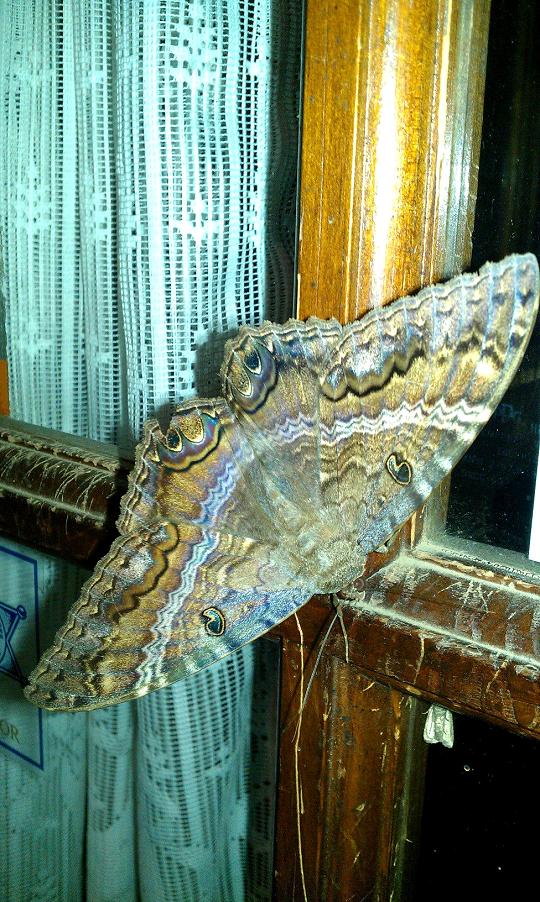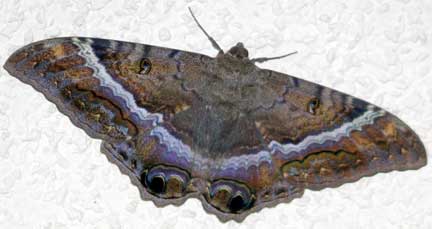Black Witch moths are making themselves known in South Texas again. The large, harmless moths appear seasonally–we had one at the ranch this weekend.
Here’s a great shot from Karen Hermann of the fascinating creatures, which often roost in the eaves of front doors resulting in a creepy “startle factor” when they’re flushed by those returning home. Special thanks to entomologist extraoridnaire Mike Quinn of Austin-based www.texasento.net for helping gather much of the info for this post.
The intriguing Ascalapha odorata, sometimes known as “the bat moth” resembles a bat in size and shape and with its seven-inch wingspan is the largest moth in North America. They are common in these parts.
Reports of large, bat-like moths surprising people, frequently as they return home and are unlocking their front door, are not uncommon. Because of their dramatic size, when these big boys flush, they get your attention.

Black Witch Moth Caterpillars like legumes and can reach three inches. Photo via www.texasento.net
Females have a white, sometimes iridescent stripe across their wings with wings open. Males exhibit the plain, grey, brown mottled pattern commonly associated with moths, but with small dark eyespots on each forewing. Black Witch Moth caterpillars eat legumes, and favor acacia and mesquite. They are perfectly harmless, not an agricultural pest, and have no teeth or stingers.
The folklore surrounding Black Witch Moth, like the moth itself, is all over the map. In Mexico they are known as “mariposa de la muerte,” the butterfly of death. Some believe if a Black Witch Moth enters the home of someone who is ill, the person will die.
A variation on the folk wisdom suggests that the moth must travel to each corner of the house for death to occur. The Mayans called the Black Witch x-mahani-nail, which means “the habit of entering buildings.” This moth apparently has a long history of inviting itself inside.
Interestingly, in the Caribbean, the Black Witch Moth is known as the “Money Moth” and if it visits your home, you are likely to come into cash. Here in South Texas, some believe if a Black Witch Moth roosts over your door, you will win the lottery.

Serial killer Hannibal Lechter inserted actual Black Witch Moth cocoons into the mouths of his victims in the movie, Silence of the Lambs.
Native to Central America and Mexico, the Black Witch starts migrating north in late spring. The Black Witches’ large wingspan allows them to cover a lot of ground quickly. Entomologists note that Monarch butterflies start crossing the Rio Grande and take two months to reach Canada. Black Witches start migrating in June and have been recorded reaching Maine by June 9 and Manitoba, Canada, by June 28. That’s a rapid pace for a moth. Scientists wonder why the Black Witch Moth migrates so far north with no southbound return? Hmm.
In the movie Silence of the Lambs, serial killer Hannibal Lechter inserted cocoons of Black Witch Mothsinto the mouths of his victims as a weird gesture of transformation. The moth on the movie poster is a Death’s Head Hawk Moth, but the actual cocoon was that of a Black Witch.
If you’d like to have one roost above your door to inspire a winning lottery ticket, you might try setting out a cocktail of fermented fruit or stale beer. Black Witch Moths also like tree sap. Good luck!
More stories like this:
Like what you’re reading? Don’t miss a single article from the Texas Butterfly Ranch. Sign up for email delivery at the bottom of this page, like us on Facebook, follow us on Twitter, @monikam or on Instagram.



This is so interesting. Having relocated recently from Minneapolis to Cape Coral, I have not seen this species of moth. Thank you.
It makes me sad that so stunningly beautiful and benign a creature (I found an injured one some years back and it rested on my hand for an hour) has inspired associations with death and murder. This post would have been so much nicer without that horrible photo of Hannibal Lecter.
Actually the hanabal character inserted spinx moth also a genus Acherontia. Get the facts straight.
Incorrect. Sphinx moths pupate under ground and don’t make cocoons. This story is correct.
Ah, the Death’s Head Hawk Moth and the Black Witch Moth. Both gorgeous. As a matter of curiosity, I thought I remembered, from the book, a reference to the Death’s Head. When you say the “actual cocoons” were Witch Moths’, is that because you saw them in the movie? Ken
Hi Ken,
I believe I read that on the IMDB movie trivia database. Here’s a link that goes into more detail:
https://texasbutterflyranch.com/2012/06/21/loathed-by-gardeners-tomato-hornworms-morph-into-magnificent-sphinx-moths/
Thanks for writing. MM
We have a black witch moth outside our front door this morning! We’re in San Diego and we’re trying to get a few good pics.
We have a Black Witch Moth outside our front door this morning! We’re in San Diego and are trying to get a few pics.
These insects are my biggest fear, i would freeze and start crying i one of those was in a room with me.
Aw, c’mon, Leo. They’re harmless. Thanks for sharing. MM
I found one on our screen door today. At first I thought it was a bat.
Correct me if I’m wrong, but Hannibal Lechter didn’t put moth pupae into the victim’s mouths, he helped law enforcement find “Buffalo Bill” who was using the pupae (and raising the moths in his basement).
Cool moths. I would love to photograph them but I’m a little far north in Michigan!
Had one fly into my patio in Las Cruces, NM this evening at dusk, thought it was a bat till it landed.
”
In the movie Silence of the Lambs, serial killer Hannibal Lechter inserted cocoons of Black Witch Moths into the mouths of his victims as a weird gesture of transformation.
” is *not* a correct reference to the plot of “Silence of the Lambs”. 🙂 At the time this cocoon stuff is happening, *fortunately* Hannibal is already behind bars! Actually Clarice Starling (played by Jodie Foster) consults with Hannibal Lecter (played by Anthony Hopkins) to help track down the killer who is doing the “cocoon” thing. Not only two of my favorite actors, but based on a novel written by Thomas Harris (who I wish would write *more*, but I guess it’s not too much fun for him to actually write 🙁 ). Last but not least, I’m not sure, but I think I just saw one of these moths! (Round Rock Texas) Thank you *so* much for your site!
6 miles south of Gering Ne. We have had one of these moths hanging around the last few mornings. Have not been able to get a picture. Thought it was a bat at first.
July 2, 2015 We currently have one resting on our deck in Brighton, CO. I have taken several photos of it and it is indeed a male-no white stripe in the midline of its wings. We have never seen one here before and are rather intrigued by it.
Found a large male under the eaves of our house in San Diego. I’ve been trying to coax it to hang out over our front door, so I have a reason to buy lotto tix. Definitely not gonna let it in the house. Not for fear of bad luck for me and my family, but we have a couple of cats that would love to hunt it down. Took a few pix and would mistake it for a bat if I saw it flying round at night. We are also huge fans of “Silence of the Lambs”. Thanks for the education!
I am down here in Costa Rica and the first night, I saw what I thought was a bat fly off as soon as I opened my front door. A few days later (today) I saw it again on the wall and realized is is a moth. I have a few pictures, so I decided to do some research, which lead me here.
there is one in the corner of my patio 5pm Wed 8/19/15 it looks like it is six inches long it is just sitting there
I am in Del Rio TX and I’ve had lots of those Black Witch moths on the stone walls of our house!!!! On another note…this time of year we are bombarded by Texas gray moths. Any way the discourage them from around our house (they’re often on the outside of the door, and when we go in or out, they fly inside)…
When I was a child of 6 living in Uvalde TX in 1977 I had a huge 10 inch moth in the house of my parents in the bathroom. I often sat and watched the moth for hours and it did not move for days then weeks. Then one day it was gone.
I am now living in the northwest and have told the stories of the huge moth to other children as I grew up. They were just as interested as I was.
Thank you for the article.
Found a female last night in Houston, Texas. It flew in my garage. While the witch moth is associated with death in Mexico, in the Bahamas it is an omen for winning the lottery. So far, I have not been affected either way but I will buy a few lottery tickets today so that I am prepared for the Bahamas folklore.
We have had several in our carport and on our porch – Del Rio
I startled a male outside the door on my way to work before 7 am. It scared me. It was the size of a bat fluttering his wings. I closed my front door and it disappeared hoping that it didn’t get inside my home. I warned my family that I was unsure if it was inside. That night it was discovered in my living room and quickly went into hiding. Early in the morning my son was awakened by sounds repeatedly scratching the walls in his room. He turned on the light and the moth went into hiding. Being determined to trap it He laid awake listening. That morning, 4 hours later he discovered it after moving his TV stand perched on the carpet. He caught it in a large container and released it outdoors. I was glad. Although these moths are harmless, they are creepy.
Amen!
Had a female one on outside door frame for two days. Far northern Wisconsin, just 20 miles south of Lake Superior. Got good picture, wasn’t beat up. Never heard of this moth before. Took several people to help identify it, but definitely female Black Witch – 6 1/4″ tip to tip. Beautiful to see. Don’t believe in all those superstitutions, but we’ll see.
Had one come up to my feet one night. It was so big I thought it was a bat.. Startled I jumped up and it crawled away. I am new here in Sugar Land Texas. Enjoying the wild life.
Found one outside my front door a couple of weeks ago—it was on the ground, and I almost stepped on it! It was gone for about 5-6 days, and then it apparently returned. This time it was just outside near the door threshold. Unfortunately it was dead:(. I am guessing it did its thing here (laid eggs) & expired.
I wish I was acquainted with the folklore, I would have purchased a lottery ticket!
I will use the photo I took and copy the patterns in a painting.
I saw my first one this morning on my patio. When it caught my eye I thought it was a bat, same dark color, same fluttering flight. Then it landed on the brick of my house and I got a fair pic. The resting wingspan appeared to be about 7” and coloring appears to be a male. What a sight it was in flight!!
Have had one on a speaker in our patio for the past 12 hours. Sure looked like a bat when it flew in. We’re in the Rio Grande Valley just north of Brownsville. Measured it at 6 inches. Appears to be a male from coloring. First time we’ve ever seen one.
I have seen two small critters that I thought were baby bats in my house; however, they crawl around like a bug and resemble large moths. I live in Virginia. How can I tell the difference?
live in new berlin, wisconsin have a black witch moth sitting front of my house.
I live in Mexico and currently I have about a dozen or ore hanging around my house. This time of year they come out. Harmless and delicate…and they leave messy dust on the walls if you kill them and they poop everywhere…little orange dots everywhere. And they will flap like crazy at the windows trying to get out I guess. They don’t have the sonar that bats do…these moths just can’t find an open door or window!